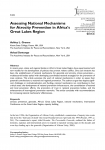Two of the Auschwitz Institute’s staff experts on atrocity prevention in the Great Lakes Region of Africa have collaborated to produce a new academic article appearing in the latest edition of the Journal of Peacebuilding and Development. Written by AIPR’s Africa Programs Director Dr. Ashad Sentongo and Academic Programs Officer for Africa and Transitional Justice Dr. Ashley Greene, “Assessing National Mechanisms for Atrocity Prevention in Africa’s Great Lakes Region” takes a broad look at the emergence of national mechanisms in the region and the contributions that these bodies have made to atrocity prevention. The article concludes with substantial recommendations for increasing the effectiveness of national mechanisms and facilitating their development into sustainable models for prevention.
After giving a brief overview of the concept of, and established working definition for, national mechanisms for genocide and atrocity crimes prevention, the authors begin the article with an examination of post-1994 prevention efforts in the Great Lakes Region of Africa. This segues into the following section, which looks at how national-level commitments agreed upon as part of the Prevention Protocol delineated in Article 8 of the 2006 Nairobi Pact on Security, Stability, and Development of the International Conference on the Great Lakes Region (ICGLR) have translated into the emergence of national mechanisms as a primary vessel for prevention at the regional level. To this end, the article explains that national mechanisms in Great Lakes region states “were designed to integrate the commitments affirmed by the ICGLR Protocol into the governmental structures of member states, with specific attention to the conflict history of each country and flash points for future violence.”
The subsequent sections are focused on the multiple ways in which national mechanisms contribute to the prevention of mass atrocities. First, the manner in which a mechanism strengthens existing national prevention infrastructure is examined. Next, the ways in which these mechanisms – manifesting here in the form of National Committees - link local or community-level prevention initiatives with those occurring at the national level are considered. This section also demonstrates the ways in which national mechanisms can act as platforms that unite existing grassroots organizations to carry out collaborative prevention initiatives.
Following this, the authors discuss the trust-building effect between communities and their national governments that functioning national mechanisms produce. Lastly, the positive impacts that national committees have on regional and international networks for atrocity prevention are highlighted. An emphasis placed on the advantageous nature of committee-level collaboration within both formal and informal preventive frameworks, as well as the cross-pollination of concepts that can take place when committee members engage in prevention work in other countries or global regions.
The article concludes with several recommendations. First, the topic of institutionalization is discussed, with Greene and Sentongo advocating for strategic approaches that involve parliamentary engagement. However, the authors underscore the dangers of combining legislation that formalizes a national committee with parallel legislative efforts to better integrate preventive measures into national ministries and legal system. They warn that legislation that is too broad can risk overwhelming or causing confusion among lawmakers that inhibits progress. Finally, the recommendation is made to adapt the vocabulary used by, and to describe, national mechanisms to “the language of state priorities.” This is to say, the preventive work done by mechanisms should be presented in a way that highlights the immediate and tangible benefits, such as the protection of significant and costly advancements made in the development realm.
“Assessing National Mechanisms for Atrocity Prevention in Africa’s Great Lakes Region” can be found in Volume 14, Issue 2 of the Journal of Peacebuilding and Development. For more information on AIPR’s Africa Programs, please click here.

